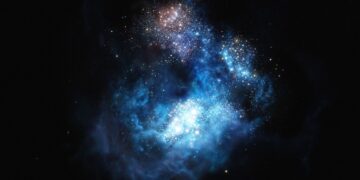Water, often referred to as the essence of life, holds a special place in the narrative of the universe. Its presence on Earth is intricately tied to the flourishing of life as we know it. But how did water, a molecule composed of hydrogen and oxygen, come to exist in the cosmos? A recent study sheds light on this question, revealing that the universe’s first supernovae might have played a pivotal role in enriching the early cosmos with water.
The Origin Story of Water in the Universe
For decades, scientists believed water’s abundance grew progressively as the universe aged. Hydrogen, forged in the fiery aftermath of the Big Bang, is the most common element in the universe. Oxygen, on the other hand, is synthesized in the cores of massive stars during their nuclear fusion processes. Together, these two elements combine to form water, but this union requires specific conditions.
The conventional belief held that water was scarce in the early universe and gradually became more common as successive generations of stars enriched the cosmos with heavier elements. However, recent findings suggest that even the earliest stars, the so-called Population III stars, could have dramatically accelerated the process of water formation.
Population III Stars: Giants of the Early Universe
Population III stars were the universe’s first-born stellar entities. Composed entirely of hydrogen and helium, these stars were massive, metal-poor, and short-lived, burning through their nuclear fuel at astonishing rates. Unlike younger stars like our Sun, which belong to Population I, these early stars were true pioneers, laying the groundwork for the chemical diversity of the cosmos.
When Population III stars reached the end of their life cycles, they exploded as supernovae, scattering heavy elements like oxygen into the surrounding space. This marked the first instance of “metal” enrichment in the universe. Recent simulations reveal that these supernovae might have played an even more extraordinary role by significantly contributing to the formation of water.
Supernovae and Water Enrichment: What the Simulations Reveal
The new study used advanced simulations to model the behavior of massive early stars, ranging from 13 to 200 times the mass of the Sun. The results were groundbreaking. When these stars exploded, they released vast quantities of oxygen into the interstellar medium. Combined with abundant hydrogen, this oxygen catalyzed the formation of water molecules in the molecular clouds left behind by the supernovae.
What’s particularly striking is the extent of water production. The molecular clouds formed from these explosions contained 10 to 30 times more water than the diffuse molecular clouds observed in the Milky Way today. This suggests that water wasn’t just a product of gradual enrichment over billions of years but a significant presence as early as 100 to 200 million years after the Big Bang.
Implications for Early Cosmic Conditions
The discovery that water formed so early in the universe’s history has profound implications. It suggests that the basic ingredients for life might have been present far earlier than previously thought. If water-rich environments existed within 200 million years of the Big Bang, the possibility of early life cannot be dismissed outright.
However, the story isn’t entirely straightforward. The intense radiation and extreme conditions of the early universe likely disrupted many of these nascent water molecules. Ionization processes could have broken apart water, leading to a “dry period” before later generations of stars replenished the cosmic reservoirs.
How This Changes Our Understanding of Life’s Beginnings
For astrobiologists, this discovery is a game-changer. It shifts the timeline for when habitable conditions might have first emerged in the universe. Traditionally, the focus has been on later generations of stars and planets, but this study suggests that even primordial molecular clouds could have harbored the potential for life.
Challenges and Future Research Directions
While the findings are groundbreaking, they also raise several challenges. For one, direct observational evidence of Population III stars and their water-rich molecular clouds remains elusive. These stars, by their very nature, have long since disappeared, leaving only their chemical fingerprints in the cosmos.
Future research will likely focus on leveraging next-generation telescopes, such as the James Webb Space Telescope (JWST) and the upcoming Nancy Grace Roman Space Telescope. These instruments are expected to provide deeper insights into the early universe, offering the potential to detect remnants of these ancient molecular clouds and confirm the presence of water.
Conclusion: A Cosmic Legacy of Life’s Building Blocks
The revelation that early supernovae flooded the universe with water challenges long-held assumptions about the chemical evolution of the cosmos. It shows that even in the universe’s infancy, the seeds for life were being sown on a grand scale.
Reference:

















